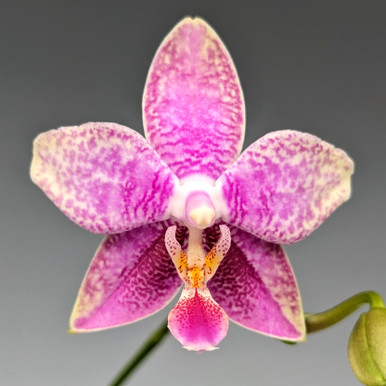Phalaenopsis Orchid Care
Commonly referred to as the "moth orchid", Phalaenopsis are one of the longest blooming orchid genera, producing flowers that last from 2 to 6 months before dropping! Phalaenopsis have also been known to bloom 2 to 3 times per year once they have reached a mature size. After it has flowered the first time, cut the stem just above the node where the first flower bloomed. From the top node a new flower stem should emerge within 2 months. If there is no response or the flower spike turns brown, cut it off near the base of the plant where it emerged.
Light and Shade
Phalaenopsis do well in shaded light (1000 to 1500 foot-candles), so that if a hand is passed over the leaves it does not produce a shadow. We recommend growing in east or west-facing windows, although the east exposure is better because the temperature is lower in the early part of the day when the plant is receiving the greatest amount of light. South-facing windows should only be used if shielded from the sun using a sheer curtain. If using artificial light to grow indoors, LEDs are the best option for orchids. Phalaenopsis prefer 11 hours of artificial light in winter, and 14 to 16 hours in summer. The artificial light market has expanded greatly in recent years, so a quick Google search will result in a variety of lighting options and price ranges.
Temperature and Humidity
Phalaenopsis orchids enjoy a fairly warm climate. These orchids do best in intermediate to warm conditions, preferring daytime temperatures of 70°F to 80°F (21°C to 27°C), and nighttime temperatures of 60°F to 65°F (16°C to 18°C). Since this temperature range is similar to that of many homes, Phalaenopsis make for ideal house plants. Phalaenopsis thrive under high humidity and will benefit from humidity levels between 50% and 70%. This can be achieved at home with the use of a humidifier or a humidity tray. Just make sure that the plant is not standing in water or the roots will rot.
Watering
Phalaenopsis like to be kept fairly moist, with the media becoming only slightly damp between waterings. During warm dry weather, they may need to be watered 2 times a week. These orchids form wilted leaves, yellowed leaf tips, and rapid yellowing throughout the oldest base leaves, when not receiving enough water. If this happens, check the root system. Over-watering may have caused the roots to rot, thereby depriving the plant from absorbing water. If the roots are healthy, you are likely under-watering and should increase your watering schedule accordingly. We always recommend watering in the morning, as this gives the leaves time to dry and avoid bacterial growth overnight. If possible, use water low in alkalinity, such as rainwater, distilled water, or reverse osmosis water. If you have a dehumidifier in your home, the water that collects in the tray is excellent for watering orchids.
Feeding
We highly recommend Green Jungle Orchid Food, specially formulated to provide orchids with the nutrients they would naturally encounter in their wild habitats. This is the fertilizer that we developed to use on our own plants in production, with excellent results for decades! This formula works best with water low in alkalinity (such as rainwater, distilled water, or reverse osmosis water). However, you may use tap water, keeping in mind that mineral buildup will require repotting more frequently, on the order of every 1 to 2 years. If potting in bark mix, fertilize every time you water, flushing with non-softened water once a month. This rinses the media of salt and mineral buildup. When potting in sphagnum moss, fertilize every 3rd watering year round.
Potting
Phalaenopsis do well in a light, porous medium, capable of holding moisture while draining thoroughly upon watering. At Orchids Limited, we recommend potting these plants in New Zealand Sphagnum Moss, or the Medium grade of our Traditional Orchid Bark Mix for plants in 5" pots or larger. Repot once per each year, preferably in the spring or fall when temperatures are mild. Remove all dead or dying roots from the plant, carefully taking off the old compost without causing damage to the live roots. If the mix is old, crumbly and sour, carefully remove the media and rinse the root system. Trim off any dead roots and dead leaves. Position the plant in the center of the pot. Then, spreading the plant roots out, fill in the space with the potting medium. To avoid the transfer of orchid diseases, it is standard procedure to sterilize all cutting and potting instruments before using them on a plant. This can be done by flaming pruning shears with a butane torch, or by spraying with rubbing alcohol and wiping with a clean paper towel.
Pest Control
The main pest that Phalaenopsis attract are mealybugs, which will hide in the leaf axis. The best treatment for mealybug is either a homemade pesticide of 1:1 parts water & rubbing alcohol, with a few drops of dish soap added. Spray the plants every few days, washing off the dead bugs in between. For large outbreaks, an application of a specially formulated pesticide spray every few days is more effective.
Bud Blast
There are many factors that can cause buds to dry up and drop off the plants without ever opening. Common care causes over or under watering, using softened water, and over-fertilizing. Environmental causes may include are temperatures reaching too high, light levels staying too low, spikes being subjected to a cool draft, and fume exposure from house work.
Featured Products
Shop all →





